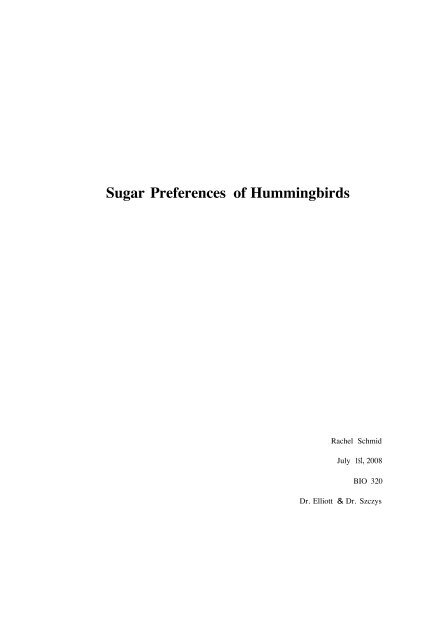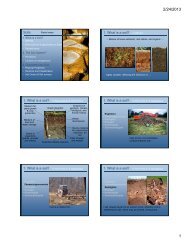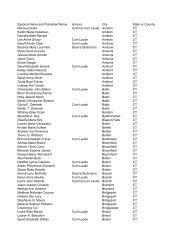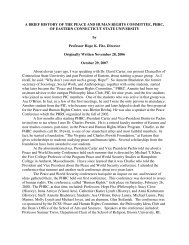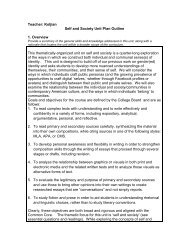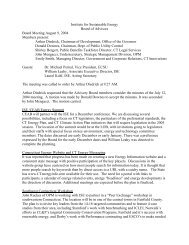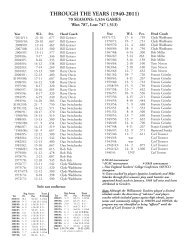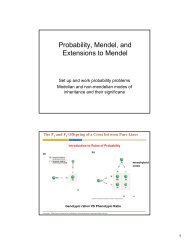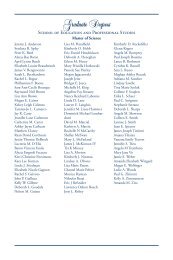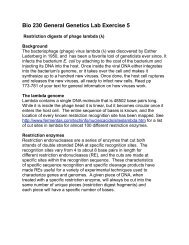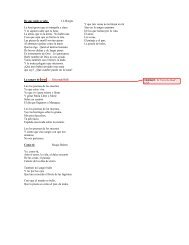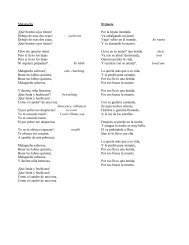Sugar Preferences of Hummingbirds
Sugar Preferences of Hummingbirds
Sugar Preferences of Hummingbirds
You also want an ePaper? Increase the reach of your titles
YUMPU automatically turns print PDFs into web optimized ePapers that Google loves.
<strong>Sugar</strong> <strong>Preferences</strong> <strong>of</strong> <strong>Hummingbirds</strong><br />
Rachel Schmid<br />
July 1st, 2008<br />
BIO 320<br />
Dr. Elliott & Dr. Szczys
Abstract. Nectar contains the sugars fructose, glucose, and sucrose, among other<br />
substances. <strong>Hummingbirds</strong> tend to consume nectars that contain a higher concentration<br />
<strong>of</strong> sucrose. In order to test my hypothesis that hummingbirds display a preference<br />
towards sucrose, I loaded flowers from a Heliconia rostrata plant with 25%<br />
concentrations <strong>of</strong> glucose, fructose, and sucrose and water to measure the frequency and<br />
length <strong>of</strong> visitation to each manipulated flower. My results showed that hummingbirds<br />
do not show a sugar preference, but my lack <strong>of</strong> data most likely affected my results.<br />
Introduction<br />
Many flowers produce nectar in order to attract pollinators such as hummingbirds.<br />
Floral nectar is used as the main source <strong>of</strong> energy for these organisms and is primarily<br />
composed <strong>of</strong> various concentrations <strong>of</strong> the disaccharide sucrose and the monosaccharides<br />
fructose and glucose (Stiles and Freeman 2003) as well as small amounts <strong>of</strong> amino acids<br />
and electrolytes (Martinez del Rio 1990; Chalc<strong>of</strong>f et al. 2008). In the Americas, the<br />
nectars associated with plants pollinated by hummingbirds predominately contain higher<br />
concentrations <strong>of</strong> the sugar sucrose than both fructose and glucose (Stiles and Freeman<br />
1993; Fleming et al. 2004; Chalc<strong>of</strong>f2008).<br />
10 3<br />
Because all <strong>of</strong> these sugars (sucrose, fructose, and glucose) contain about 16.48 x<br />
Jig <strong>of</strong> energy (Martinez del Rio 1990), the questions remain why hummingbird<br />
nectars contain higher concentrations <strong>of</strong> sucrose and if the birds actually prefer this sugar.<br />
Although several studies concerning this topic have been performed under artificial
conditions, only the study conducted that was performed in the field was by Chalc<strong>of</strong>f et<br />
al. (2008) but this was with the use <strong>of</strong> feeders. Because hummingbirds' preference can<br />
be affected by various conditions not found in the laboratory, such as territoriality, this<br />
study was conducted mimicking natural conditions as closely as possible with the use <strong>of</strong><br />
Heliconia rostrata.<br />
Materials and Methods<br />
This experiment was conducted in the botanical garden <strong>of</strong> Selva Verde Lodge<br />
located in Chilamate, Sarapiqui, Costa Rica (loo27'N, 84°4'W, elevation ~76 m) on May<br />
23-24 and 27-28,2008. The garden had a path running along its border which led into<br />
the rain forest. A frequently visited Heliconia rostrata plant located about a meter from<br />
the walkway was used for this experiment. The most frequent visitor was the Chalybura<br />
urochrysia, who appeared to claim this plant as his territory.<br />
I <strong>of</strong>fered approximately a 25% concentration <strong>of</strong> each <strong>of</strong> fructose, glucose, and<br />
sucrose as well as a control <strong>of</strong> distilled water on two separate bracts <strong>of</strong> flowers on the<br />
heliconia plant. Each day I observed, I chose the two healthiest looking bracts with the<br />
most inflorescences and each day I used different bracts located on various sides <strong>of</strong> the<br />
plant.<br />
I began by diluting previously made mixtures <strong>of</strong> both fructose and glucose to a<br />
25% concentration and then by making the sucrose solution from distilled water and table<br />
sugar. I then used a 20 µL pipette to remove the nectar from each flower and loaded 20<br />
µL <strong>of</strong> each sugar solution and water into eight different flowers, varying the height and<br />
order <strong>of</strong> solutions to avoid biases that could be made by the feeding hummingbirds. I
observed the flowers from 530 to 730 and then from 900 to 1100. During each<br />
observation period, I recorded the duration <strong>of</strong> each visit using a stopwatch and number <strong>of</strong><br />
visits to each flower by any hummingbird that fed there, noting the species.<br />
Statistical analyses - I analyzed the data using a chi square test for the number <strong>of</strong><br />
visits and a mean comparison for the duration <strong>of</strong> visit.<br />
10<br />
9<br />
8<br />
J!}<br />
·iii 7<br />
:> 6 ....<br />
0<br />
"- 5<br />
II)<br />
.c 4<br />
E<br />
;:,<br />
z 3<br />
2<br />
1<br />
0<br />
Results<br />
Visitation<br />
fructose glucose sucrose water<br />
Fig 1. The total number <strong>of</strong> recorded visits by hummingbirds to Heliconia rostrata flowers<br />
containing each solution.
. 4.5<br />
u<br />
II)<br />
CJ) 4<br />
c<br />
:: 3.5<br />
:~ 3 -<br />
><br />
'0 2.5<br />
c<br />
0<br />
:;:; 2<br />
e!<br />
;:, 1.5<br />
c II) 1<br />
CI<br />
~ 0.5<br />
><br />
« 0<br />
Duration<br />
Fructose Glucose Sucrose Water<br />
Fig. 2 The average duration <strong>of</strong> each visit by a hummingbird to a specific type <strong>of</strong><br />
treatment.<br />
I recorded 32 total visits by a plumeleteer (Chalybura urochrysia) and 1 by a long<br />
tailed hermit (Phaethornis superciliosus). The hummingbirds did not show a significant<br />
preference for any specific sugar [number <strong>of</strong> visits x 2 =.82, df=3, p=.84 and duration X2=<br />
df=3, p=.49]. They visited the flowers containing fructose, glucose, and sucrose the same<br />
number <strong>of</strong> times and water only slightly less frequently (Fig 1). Although the mean<br />
length <strong>of</strong> visitation was the longest for sucrose, there was no significant difference found<br />
among all treatments (Fig 2). The length <strong>of</strong> visitation for fructose and glucose were the<br />
closest, being 3.13 sec. for fructose and 3.19 sec. for glucose.
Discussion<br />
The hummingbirds did not show a significant preference for sucrose over<br />
fructose, glucose, or water in this experiment. Although similar experiments trying to<br />
indicate a sugar preference in hummingbirds have been performed over the past several<br />
years, there have been no conclusive answers. Experiments, such as those done by Stiles<br />
(1976), Martinez del Rio (1990), and Chalc<strong>of</strong>f et al. (2008) indicate a significant<br />
preference for sucrose over glucose and fructose by hummingbirds; whereas, Hainsworth<br />
and Wolf (1976) did not find a pr<strong>of</strong>ound preference towards any sugar, as my results<br />
agree with.<br />
Martinez del Rio (1990) provides a possible explanation for the discrepancies<br />
based on the experimental differences among the tests. The results show that<br />
hummingbirds that have been exposed to the sugar variations for long periods <strong>of</strong> time, (4-<br />
48 hours) show significant sucrose preferences, but those where the sugars are alternated<br />
frequently (Hainsworth and Wolf, 1976) show no preference toward sucrose. This may<br />
indicate that hummingbirds need several hours, and thus numerous feeding sessions, to<br />
acclimate to the differences among the sugars and indicate a preference. Because I did<br />
not alternate the position <strong>of</strong> my sugar solutions throughout the day, I should have found a<br />
significant preference towards sucrose, based on previous tests. The fact that I did not<br />
perform my experiments continuously and that I rotated the position <strong>of</strong> the sugars each<br />
morning may have affected the significance <strong>of</strong> my results. Also, none <strong>of</strong> the<br />
aforementioned experiments were conducted with real flowers and the one performed by<br />
Chalc<strong>of</strong>f et al. (2008) was the first to be located in a natural setting, <strong>of</strong>fering all choices at<br />
the same time. Many <strong>of</strong> the other experiments were performed in artificial conditions
where the hummingbirds were <strong>of</strong>fered the various sugars in pairs (Hainsworth and Wolf,<br />
1976; Martinez del Rio, 1990). Because I manipulated relatively few flowers on the<br />
entire plant, this could have affected the frequency <strong>of</strong> visitation because <strong>of</strong> the vast<br />
choices <strong>of</strong> flowers the hummingbirds had. Given that I was only able to collect a<br />
minimal amount <strong>of</strong> data, the quality <strong>of</strong> my results may be skewed based on the quantity<br />
<strong>of</strong> data I was able to collect.<br />
Although my results show that hummingbirds do not show a preference towards<br />
any sugar, it is confounding why the nectars these birds ingest most frequently have<br />
higher concentrations <strong>of</strong> sucrose than fructose or glucose (Freeman et aI., 1984; Stiles<br />
and Freeman, 1993; Chalc<strong>of</strong>f, 2008). Martinez del Rio (1990) hypothesizes that<br />
hummingbirds prefer sucrose because they are taught to, not because it is more easily<br />
digested or more energetically beneficial than glucose and fructose. He proposes that<br />
"food imprinting," where, in this case, a hummingbird prefers the taste <strong>of</strong>the nectar<br />
given to it early in its life by its mother later in life, plays a dominate role in<br />
hummingbird nectar choices.<br />
The ecologically accepted "ornithocentric explanation" provides that over time,<br />
plants develop different sugar concentrations in their nectars based on the digestive<br />
preferences <strong>of</strong> specific birds in order to increase its chance <strong>of</strong> pollination (Fleming et aI.,<br />
2004; Chalc<strong>of</strong>f, 2008). The explanation contradicts Martinez del Rio's hypothesis and<br />
the results that Fleming et aI. (2004) found. The contrast to the "ornithocentric<br />
explanation" is the "plant-centered explanation" (Chalc<strong>of</strong>f, 2008) that suggests that plant<br />
physiology and floral morphology are the key factors that affect sugar concentrations in
..<br />
nectar, thus causing birds species to adapt (Fleming et aI., 2004; Chalc<strong>of</strong>f, 2008). None<br />
have been proven.<br />
Literature Cited<br />
Chalc<strong>of</strong>f, V.R., M.A. Aizen, and L. Galetto. 2008. <strong>Sugar</strong> preferences <strong>of</strong> the green-backed<br />
firecrown hummingbird (Sephanoides sephaniodes): A field experiment. Auk<br />
115:60-66.<br />
Fleming, P.A., B. Hartman Bakken, C.N. Lotz, and S.W. Nicolson. 2004. Concentration<br />
and temperature effects on sugar intake and preferences in a sunbird and a<br />
hummingbird. Functional Ecology 18:223-232.<br />
Freeman, C.E., W.H. Reid, J.E. Becvar, and R. Scogin. 1984. Similarity and apparent<br />
convergence in the nectar-sugar composition <strong>of</strong> some hummingbird-pollinated<br />
flowers. Botanical Magazine 145:132-135.<br />
Hainsworth, F.R., and L.L.WOLF. 1976. Nectar characteristics and food selection by<br />
hummingbirds. Oecologia 25:101-113.<br />
Martinez del Rio, C. 1990. <strong>Sugar</strong> preferences in hummingbirds: The influence <strong>of</strong> subtle<br />
chemical differences on food choice. Condor 92: 1022-1 030.<br />
Stiles, F.G. 1976. Taste preferences, color preferences, and flower choice in<br />
hummingbirds. Condor 78:10-26.<br />
Stiles, F.G., and C.E. Freeman. 1993. Patterns in floral nectar characteristics <strong>of</strong> some<br />
bird-visited plant species from Costa Rica. Biotropica 25:191-205.


